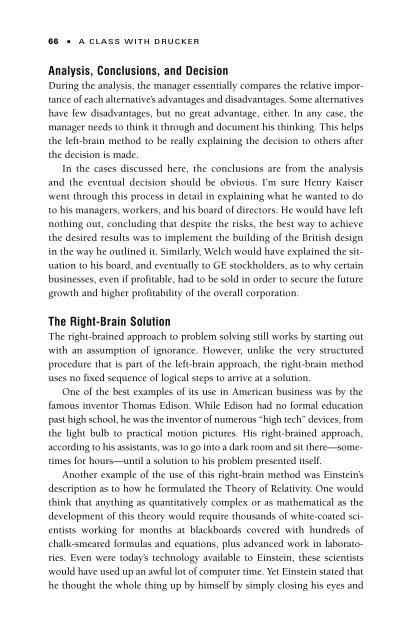A Class with Drucker - Headway | Work on yourself
A Class with Drucker - Headway | Work on yourself
A Class with Drucker - Headway | Work on yourself
You also want an ePaper? Increase the reach of your titles
YUMPU automatically turns print PDFs into web optimized ePapers that Google loves.
66 ■ A CLASS WITH DRUCKER<br />
Analysis, C<strong>on</strong>clusi<strong>on</strong>s, and Decisi<strong>on</strong><br />
During the analysis, the manager essentially compares the relative importance<br />
of each alternative’s advantages and disadvantages. Some alternatives<br />
have few disadvantages, but no great advantage, either. In any case, the<br />
manager needs to think it through and document his thinking. This helps<br />
the left-brain method to be really explaining the decisi<strong>on</strong> to others after<br />
the decisi<strong>on</strong> is made.<br />
In the cases discussed here, the c<strong>on</strong>clusi<strong>on</strong>s are from the analysis<br />
and the eventual decisi<strong>on</strong> should be obvious. I’m sure Henry Kaiser<br />
went through this process in detail in explaining what he wanted to do<br />
to his managers, workers, and his board of directors. He would have left<br />
nothing out, c<strong>on</strong>cluding that despite the risks, the best way to achieve<br />
the desired results was to implement the building of the British design<br />
in the way he outlined it. Similarly, Welch would have explained the situati<strong>on</strong><br />
to his board, and eventually to GE stockholders, as to why certain<br />
businesses, even if profitable, had to be sold in order to secure the future<br />
growth and higher profitability of the overall corporati<strong>on</strong>.<br />
The Right-Brain Soluti<strong>on</strong><br />
The right-brained approach to problem solving still works by starting out<br />
<str<strong>on</strong>g>with</str<strong>on</strong>g> an assumpti<strong>on</strong> of ignorance. However, unlike the very structured<br />
procedure that is part of the left-brain approach, the right-brain method<br />
uses no fixed sequence of logical steps to arrive at a soluti<strong>on</strong>.<br />
One of the best examples of its use in American business was by the<br />
famous inventor Thomas Edis<strong>on</strong>. While Edis<strong>on</strong> had no formal educati<strong>on</strong><br />
past high school, he was the inventor of numerous “high tech” devices, from<br />
the light bulb to practical moti<strong>on</strong> pictures. His right-brained approach,<br />
according to his assistants, was to go into a dark room and sit there—sometimes<br />
for hours—until a soluti<strong>on</strong> to his problem presented itself.<br />
Another example of the use of this right-brain method was Einstein’s<br />
descripti<strong>on</strong> as to how he formulated the Theory of Relativity. One would<br />
think that anything as quantitatively complex or as mathematical as the<br />
development of this theory would require thousands of white-coated scientists<br />
working for m<strong>on</strong>ths at blackboards covered <str<strong>on</strong>g>with</str<strong>on</strong>g> hundreds of<br />
chalk-smeared formulas and equati<strong>on</strong>s, plus advanced work in laboratories.<br />
Even were today’s technology available to Einstein, these scientists<br />
would have used up an awful lot of computer time. Yet Einstein stated that<br />
he thought the whole thing up by himself by simply closing his eyes and


